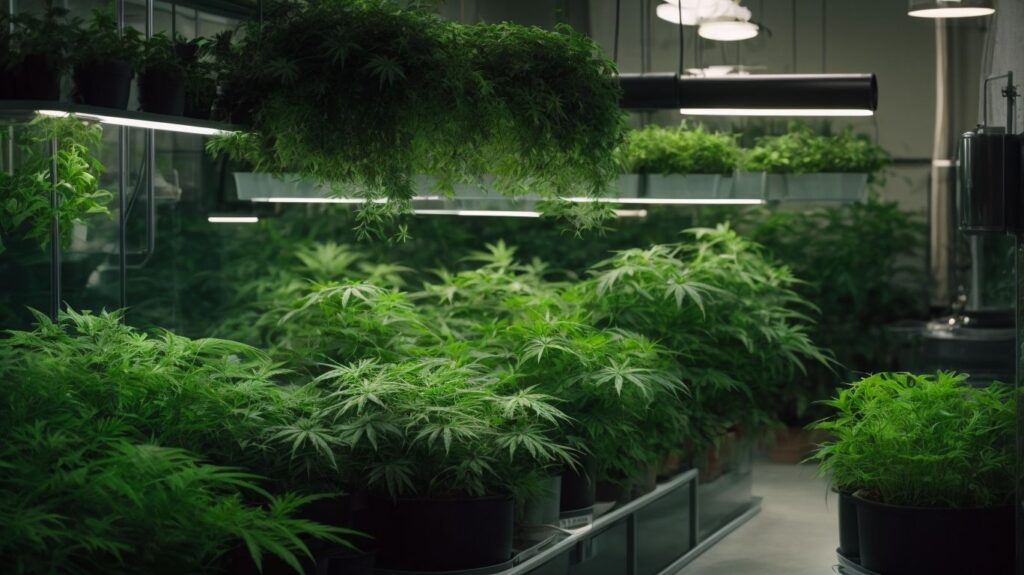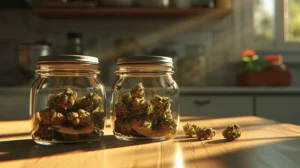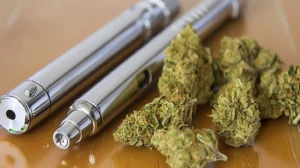Hydroponics is a method of growing plants without soil, using nutrient-rich water as the growing medium. It has gained popularity in recent years for its efficiency and ability to produce higher yields. When it comes to growing cannabis, hydroponics offers several advantages, including faster growth, better nutrient absorption, and the ability to control environmental factors such as lighting and humidity.
In this guide, we will discuss the basic components of a hydroponic system, how to set up a simple system for growing cannabis at home, the best types of hydroponic systems for cannabis, and common mistakes to avoid.
Before setting up a hydroponic system, it is important to understand the basic components. These include a growing container, growing medium, nutrient solution, and water pump and reservoir. The growing container can be any type of container that can hold plants and water, such as a bucket or tub. The growing medium is used to support the plant’s roots and can include materials like perlite, clay pellets, or rockwool. The nutrient solution is a mixture of water and essential plant nutrients, and the water pump and reservoir help circulate and supply the solution to the plants.
To set up a simple hydroponic system for growing cannabis at home, follow these steps:
- Choose a suitable location with access to electricity and a water source.
- Prepare the growing container by drilling holes for the plants and water pump.
- Add the growing medium to the container, filling it about two-thirds full.
- Set up the water pump and reservoir, making sure to follow the manufacturer’s instructions.
- Mix the nutrient solution according to the package instructions and add it to the reservoir.
- Plant the cannabis seedlings in the growing medium, making sure the roots are submerged in the nutrient solution.
There are several types of hydroponic systems that can be used for growing cannabis at home. These include deep water culture (DWC), ebb and flow, drip system, and nutrient film technique (NFT). Each system has its own advantages and disadvantages, so it is important to research and choose the best fit for your needs and space.
When setting up a hydroponic system for growing cannabis, there are common mistakes that should be avoided. These include not providing adequate lighting, overfeeding or underfeeding nutrients, not monitoring pH levels, and not properly sterilizing equipment. Providing the correct lighting is crucial for plant growth, while over or underfeeding nutrients can lead to stunted growth or nutrient deficiencies. Monitoring and adjusting pH levels is important for nutrient absorption, and not properly sterilizing equipment can lead to pest or disease issues.
Once the hydroponic system is set up, it is important to properly maintain and troubleshoot it. This includes regularly checking and adjusting pH levels, monitoring nutrient levels, keeping the system clean and sterile, and addressing any plant or system issues promptly.
By following these guidelines, you can successfully set up and maintain a simple hydroponic system for growing cannabis at home.
Key Takeaways:
Selecting the right location and preparing the growing container are key to a successful hydroponic cannabis system. Choose a suitable hydroponic technique and ensure proper nutrient levels to avoid common mistakes like overfeeding. Regular monitoring and maintenance of pH and cleanliness is crucial for healthy cannabis growth in a hydroponic system.
Growing Container
When choosing a growing container for your hydroponic cannabis setup, consider factors like size, material, and drainage. Ensure the container is large enough to accommodate the plant’s root system as it grows. Opt for food-grade plastic or non-toxic materials to prevent leaching of harmful substances into the nutrient solution. Additionally, the container should have adequate drainage to prevent waterlogging, which can lead to root rot. Common options include plastic buckets, net pots, or specially designed hydroponic containers.
A friend of mine set up a hydroponic cannabis system using a large plastic storage container with proper drainage holes. The setup allowed him to control the plant’s environment effectively, resulting in healthy, high-yielding crops. The simplicity of the container choice made the entire process more manageable and efficient.
Growing Medium
When considering the growing medium for your cannabis hydroponic system, options like perlite, coco coir, and clay pebbles are popular choices. Perlite, being lightweight and porous, offers excellent oxygenation for the roots. Coco coir, derived from coconut husks, provides good water retention and aeration. Clay pebbles are suitable for systems with high-flow rates due to their drainage properties. Each medium has its advantages, so selecting one depends on factors like water retention, aeration, and the specific needs of the cannabis plant. Additionally, always ensure the growing medium is sterile to prevent the growth of harmful fungi or bacteria. Lastly, a pro-tip: Consider combining different growing mediums to create an optimal environment for your cannabis plants, ensuring a balance of moisture retention and adequate aeration.
Nutrient Solution
When preparing a nutrient solution for your hydroponic cannabis setup, follow these steps for optimal plant growth:
- Measure: Accurately measure the required amount of water based on your system’s size.
- Adjust pH: Use a pH testing kit to check the solution’s pH level and adjust it to the recommended range of 5.5 to 6.5.
- Add nutrients: Mix the appropriate hydroponic nutrient solution, ensuring it contains essential elements like nitrogen, phosphorus, and potassium.
- Mix thoroughly: Stir the solution well to ensure even distribution of nutrients.
- Monitor and adjust: Regularly check the pH and nutrient levels to maintain an optimal growing environment.
A friend of mine, passionate about indoor gardening, diligently followed the steps to create a nutrient solution for his hydroponic cannabis system. The results were impressive, with healthy, thriving plants and potent yields.
Water Pump and Reservoir
Choose an appropriate water pump based on the size of your hydroponic system and the water flow required. Ensure the water pump is equipped with a filter to prevent clogging and maintain the cleanliness of the system. Select a reservoir that can hold enough water to meet the needs of your plants and fits within the available space. Place the water pump in the reservoir, ensuring it is submerged in the water but not in contact with the reservoir’s base to avoid drawing sediments. Connect the water pump to a timer to automate the watering cycles for your cannabis plants. Regularly clean and maintain the water pump and reservoir to prevent the buildup of algae or bacterial growth.
Fact: Properly maintaining the water pump and reservoir is essential for the overall health and productivity of your hydroponically grown cannabis plants.
Choose a Suitable Location
Consider the space:
- Choose a location with ample space to accommodate the hydroponic system and allow for plant growth.
- Access to utilities:
- Ensure the chosen location has access to water and electricity for the hydroponic system’s operation.
- Lighting conditions:
- Select an area with good natural light or the ability to set up artificial lighting to support optimal plant growth.
- Temperature and humidity:
- Maintain a stable environment by choosing a location with suitable temperature and humidity levels for cannabis cultivation.
- Safety and security:
- Prioritise safety and security by choosing a location that is private, secure, and suitable for the legal cultivation of cannabis.
When choosing a suitable location for your hydroponic cannabis setup, prioritise factors such as space, access to utilities, lighting conditions, environmental stability, and safety. Remember to comply with local regulations regarding cannabis cultivation and create a conducive space for successful and responsible homegrown cannabis production.
Prepare the Growing Container
Choose a container: Select a suitable container based on the plant’s size and the hydroponic system type. Options include buckets, storage totes, PVC pipes, or customized hydroponic containers.
Clean the container: Thoroughly wash and disinfect the chosen container to remove any dirt, debris, or pathogens that could harm the plant’s root system.
Drill drainage holes: Create adequate drainage holes in the bottom of the container to prevent waterlogging and ensure proper oxygenation for the roots.
Set up the reservoir: If using a separate reservoir for the nutrient solution, ensure it fits securely within the container and is easily accessible for maintenance.
Prepare the medium: Add the chosen hydroponic growing medium, such as perlite, clay pellets, or rockwool, to the container, ensuring it’s clean and free from contaminants.
Add the Growing Medium
Prepare the growing medium by choosing options such as coco coir, perlite, vermiculite, or a mixture of these. Ensure the medium provides good aeration, drainage, and support for the plants’ root systems. Soak the growing medium in water to hydrate it before placing it in the hydroponic system. Adjust the pH of the medium to the suitable range for cannabis cultivation, generally between 5.5 and 6.5.
After adjusting pH, fill the growing containers or trays with the moistened medium, leaving enough space for the cannabis plants to grow. When choosing the growing medium, consider the specific needs of cannabis plants and the overall system setup. Ensure proper hydration and pH levels to support healthy plant growth.
Set Up the Water Pump and Reservoir
Position the water pump in the reservoir, making sure it is fully submerged. Connect the tubing from the water pump to the top of the growing container. Fill the reservoir with the appropriate nutrient solution, leaving enough space for the water pump to operate effectively. Secure the lid of the reservoir to prevent light from entering, which could lead to algae growth.
Pro-tip: Regularly check the water pump and tubing for any blockages or malfunctions to maintain an efficient hydroponic system.
Mix and Add the Nutrient Solution
- First, fill your reservoir with water, ensuring it’s at the right temperature for your plants.
- Then, measure out the appropriate amount of hydroponic nutrients for your water volume.
- After that, add the nutrients to the water one at a time, stirring thoroughly between each addition.
- Next, check the pH level of the nutrient solution and adjust it as needed using pH up or down solutions.
- Lastly, let the nutrient solution mix for a few hours before using it to water your hydroponic cannabis plants.
Plant the Cannabis Seedlings
Prepare the growing medium:
Use a soilless medium like peat moss, coco coir, or vermiculite for hydroponic growth. Ensure the medium is well-aerated and provides good support for the seedlings.
Place the seedlings:
Gently remove the seedlings from their containers and transplant them into the prepared growing medium. Make sure the root system is not damaged during this process.
Provide adequate lighting:
Position the grow lights at an appropriate distance from the seedlings to ensure they receive sufficient light for healthy growth. Adjust the lighting schedule to provide the recommended amount of light per day.
Maintain optimal environmental conditions:
Monitor and regulate the temperature, humidity, and airflow in the growing area to create an ideal environment for the cannabis seedlings.
Water the seedlings:
Carefully water the seedlings with a nutrient solution suitable for hydroponic systems. Ensure the medium is evenly moist but not waterlogged to promote healthy root development.
Deep Water Culture
Start by obtaining a suitable container for the deep water culture system. This could be a bucket, tub, or reservoir, depending on the scale of your setup.
Next, install an air pump and air stone in the container to ensure proper oxygenation of the nutrient solution.
Prepare the nutrient solution by mixing water with hydroponic nutrients designed for deep water culture systems.
Place the plant into a net pot and suspend it over the container so that the roots will be submerged in the nutrient solution.
Monitor the water level and pH of the nutrient solution regularly to maintain optimal growing conditions for the cannabis plant.
Lastly, ensure that the growing area has sufficient light, preferably using grow lights, to support the cannabis plant’s photosynthesis process.
Ebb and Flow
When implementing an ebb and flow hydroponic system, it’s crucial to ensure proper timing for flooding and draining. This method involves periodically flooding the grow tray with nutrient solution and then allowing it to ebb away. The ebb and flow technique provides oxygen to the roots, preventing waterlogging and promoting healthy plant growth. The flood cycles should be frequent enough to keep the roots moist but not overly saturated. Typically, a 15-30 minute flood cycle every 2-4 hours is effective for most plants.
This system offers flexibility and is suitable for various plant types, including cannabis. An ebb and flow hydroponic setup is an efficient way to deliver nutrients and water to your cannabis plants, fostering robust growth and high yields.
Drip System
Choose a suitable dripper system based on the size and layout of your hydroponic cannabis setup, ensuring it provides consistent and even water distribution.
Connect the drip lines to the water source, such as a reservoir or water pump, and ensure the lines reach all plants in the system.
Set up a timer to automate the drip system, ensuring that the plants receive water at regular intervals for optimal growth.
Monitor the drip system regularly to check for clogs, leaks, or any irregularities that may affect its performance.
Adjust the flow rate and timing of the drippers as the cannabis plants grow to meet their changing water needs.
Nutrient Film Technique
The nutrient film technique (NFT) is a hydroponic growing method where a shallow stream of nutrient-rich water is circulated along the bottom of the plant roots. When implementing NFT for cannabis cultivation, it’s crucial to maintain a consistent flow of nutrient solution to ensure the roots receive an adequate supply of water and nutrients. The system should be designed to prevent clogging and ensure continuous flow. Monitoring the pH and EC levels of the nutrient solution is essential for optimal plant growth. Additionally, regular maintenance and cleaning of the NFT system are necessary to prevent algae or bacterial growth, which can disrupt the nutrient flow and harm the plants.
Not Providing Adequate Lighting
When cultivating cannabis using a hydroponic system, not providing adequate lighting can hinder the plant’s growth and yield. Insufficient light may lead to stunted growth, poor flowering, and lower potency.
To ensure optimal lighting, consider using LED grow lights, which provide the necessary spectrum for different growth stages. For instance, during the vegetative stage, cannabis plants require blue spectrum light, while the flowering stage benefits from red spectrum light.
Additionally, monitor the light intensity and duration to mimic natural sunlight conditions. Providing the right amount of light is crucial for healthy and vigorous cannabis plants, ultimately influencing the quality and quantity of the harvest.
Overfeeding or Underfeeding Nutrients
Monitor plant response: Watch for signs of overfeeding or underfeeding nutrients such as yellowing or browning of leaves, stunted growth, or nutrient burn.
Follow feeding schedule: Adhere to a well-structured feeding schedule, considering the plant’s growth stage and adjusting nutrient levels accordingly.
Use appropriate tools: Employ pH and TDS meters to accurately measure nutrient levels and pH balance in the water solution.
Adjust nutrient strength: Gradually increase or decrease nutrient strength to prevent abrupt changes that may stress the plants.
Flush the system: If overfeeding occurs, flush the system with pH-balanced water to remove excess nutrients, allowing the plants to recover.
Fact: Overfeeding or underfeeding nutrients can significantly impact cannabis yield and quality, making it crucial to maintain a balanced nutrient regimen for successful hydroponic cultivation.
Not Monitoring pH Levels
Not monitoring pH levels can lead to nutrient lockout, affecting plant health and growth. Invest in a reliable pH meter and monitor the pH levels of the nutrient solution regularly. Adjust pH levels using pH up or down solutions to maintain the optimal range for cannabis cultivation, which is typically between 5.5 and 6.5.
Pro-tip: Consistent pH monitoring and adjustment is crucial for maximising nutrient uptake and ensuring healthy, vigorous cannabis plants.
Not Properly Sterilizing Equipment
- Inspect equipment: Before use, carefully examine all hydroponic system components to ensure they are clean and free from any contaminants or debris.
- Clean with soap and water: Thoroughly wash all equipment with a gentle, non-toxic soap and warm water to remove any dirt, dust, or organic matter.
- Sterilize with hydrogen peroxide: Use a solution of hydrogen peroxide to sterilize the equipment, including reservoirs, pumps, tubing, and grow mediums to eliminate any bacteria, fungi, or pathogens.
- Rinse thoroughly: After sterilization, rinse all components with clean water to remove any residual hydrogen peroxide or soap.
- Maintain cleanliness: Regularly inspect and clean the hydroponic system to prevent the build-up of algae, mould, or other contaminants that may impact plant health.
Regularly Check and Adjust pH Levels
Regularly monitor pH levels:
Invest in a reliable pH meter and check the nutrient solution’s pH levels at least once a day. Aim for a pH range between 5.5 and 6.5 for cannabis cultivation.
Adjust pH levels:
If the pH deviates from the optimal range, use pH-up or pH-down solutions to make necessary adjustments. Gradually add the solution while stirring and recheck the pH until it reaches the desired range.
Maintain consistency:
Fluctuating pH levels can hinder nutrient uptake. Ensure the pH remains stable to facilitate proper nutrient absorption and overall plant health.
Monitor Nutrient Levels and Adjust as Needed
Regular Monitoring:
Check the nutrient levels in the hydroponic system at least once a week to ensure they are within the optimal range.
Adjustment:
If the nutrient levels are not at the desired range, make the necessary adjustments by adding more nutrients or adjusting the pH level.
Observation:
Monitor the plant’s growth and overall health to gauge the effectiveness of the nutrient levels. Adjust as needed based on the plant’s response.
Record Keeping:
Keep a log of the nutrient levels, adjustments made, and the plant’s response to maintain a consistent and healthy nutrient regimen.
Keep the System Clean and Sterile
Clean the system regularly by wiping down all surfaces with a mild bleach solution to prevent the growth of algae and bacteria. Use sterilised equipment and tools when handling the hydroponic system to avoid introducing contaminants. Ensure that the water reservoir is kept free from debris and organic matter to maintain a sterile environment for the plant roots. Inspect and clean the irrigation system, including pipes, tubes, and drip emitters, to prevent clogging and blockages that can harbour pathogens. Monitor the pH and nutrient levels regularly to prevent imbalances that can lead to microbial growth and affect plant health.
Address Any Plant or System Issues Promptly
Monitor: Regularly check plants for signs of yellowing, spotting, or drooping. Check the pH and nutrient levels in the hydroponic system.
Identify: Identify the specific issues affecting the plants or the hydroponic setup, such as nutrient deficiencies, pH imbalance, pests, or root rot.
Research: Use reliable sources to diagnose the problems and find appropriate solutions, ensuring the information relates to hydroponic cannabis cultivation.
Act: Address any plant or system issues promptly to prevent further damage and optimise plant health and growth.
Adjust: Implement the necessary modifications to the nutrient solution, pH levels, or environmental conditions based on the identified issues and recommended solutions.
Summary
When considering a hydroponic system for growing cannabis at home, several key points should be taken into account. It’s essential to choose the right hydroponic system based on space, budget, and experience level. Factors such as nutrient solutions, pH levels, and lighting are critical to plant growth in a hydroponic setup. Additionally, maintaining proper ventilation and temperature control is crucial for a successful cannabis harvest.
For beginners, starting with a simple deep water culture or nutrient film technique system can be advantageous. However, for more experienced growers, an ebb and flow or drip system might be suitable. Ultimately, understanding the essentials of hydroponic systems and tailoring them to specific needs is paramount for a successful cannabis cultivation venture.
For more in-depth guidance, referring to reputable online resources or consulting with experienced growers is highly recommended.
Frequently Asked Questions
1. What is hydroponics and how does it differ from traditional soil cultivation?
Hydroponics is a method of growing plants, including cannabis, in a water and nutrient solution without the use of soil. This differs from traditional soil cultivation where plants are grown in soil and receive nutrients through the soil.
2. What are the advantages of setting up a simple hydroponic system for growing cannabis at home?
There are several advantages to growing cannabis using hydroponics. These include faster growth rate, higher yields (30-50% more than soil-grown), and space-saving due to the absence of soil. It also allows for precise dosing of nutrients and easier nutrient delivery.
3. What type of hydroponics should beginners use for growing cannabis at home?
For beginners, a simple and efficient hydroponic method to consider is the Deep Water Culture (DWC). This involves hanging plant roots in a water and nutrient solution, and has been used for over 100 years by horticultural specialists and even “mad scientists”.
4. Do I need any special equipment to set up a hydroponic system for growing cannabis?
Yes, you will need some basic supplies and equipment such as an inert medium like coco coir or rock wool blocks, a reservoir, air stones, a water-based nutrient solution, and grow lamps. A pH test kit, good bacteria supplement, and white paint for the grow room are also recommended.
5. Can I use my hydroponic system for growing other plants besides cannabis?
Yes, hydroponics can be used to grow a variety of plants, including vegetables, fruits, and herbs. It is a soil-free method of gardening that is gaining popularity for its efficient process and clean white paint. Just make sure to use the appropriate nutrient solution for the specific plant you are growing.
6. Are there any potential risks or disadvantages to hydroponically growing cannabis?
Some potential risks and disadvantages of hydroponic gardening include the potential for root rot if not using a good bacteria supplement, the need for more preparation and setup compared to traditional soil growing methods, and a learning curve for those more familiar with soil gardening. However, with proper care and maintenance, these risks can be minimized and the benefits of faster growth and potentially more potent buds can be enjoyed.
Stay Connected with the Latest in Hydroponics! Subscribe to our newsletter and dive into the world of efficient and sustainable gardening. Every issue is packed with expert tips, DIY guides, and the latest trends in hydroponics and indoor farming. Don’t miss out on exclusive content, community stories, and special offers tailored just for you. Click here to subscribe and transform your gardening experience today!






